Newspaper Industry Challenges and Adaptations
VerifiedAdded on 2020/05/16
|9
|2233
|160
AI Summary
This assignment examines the multifaceted challenges confronting the newspaper industry in the digital age. It delves into declining print readership, the impact of online media giants, and financial pressures. Furthermore, it analyzes various adaptation strategies employed by newspapers, such as embracing digital platforms, diversifying revenue streams, and fostering a culture of innovation. Leadership styles relevant to navigating these challenges are also explored.
Contribute Materials
Your contribution can guide someone’s learning journey. Share your
documents today.
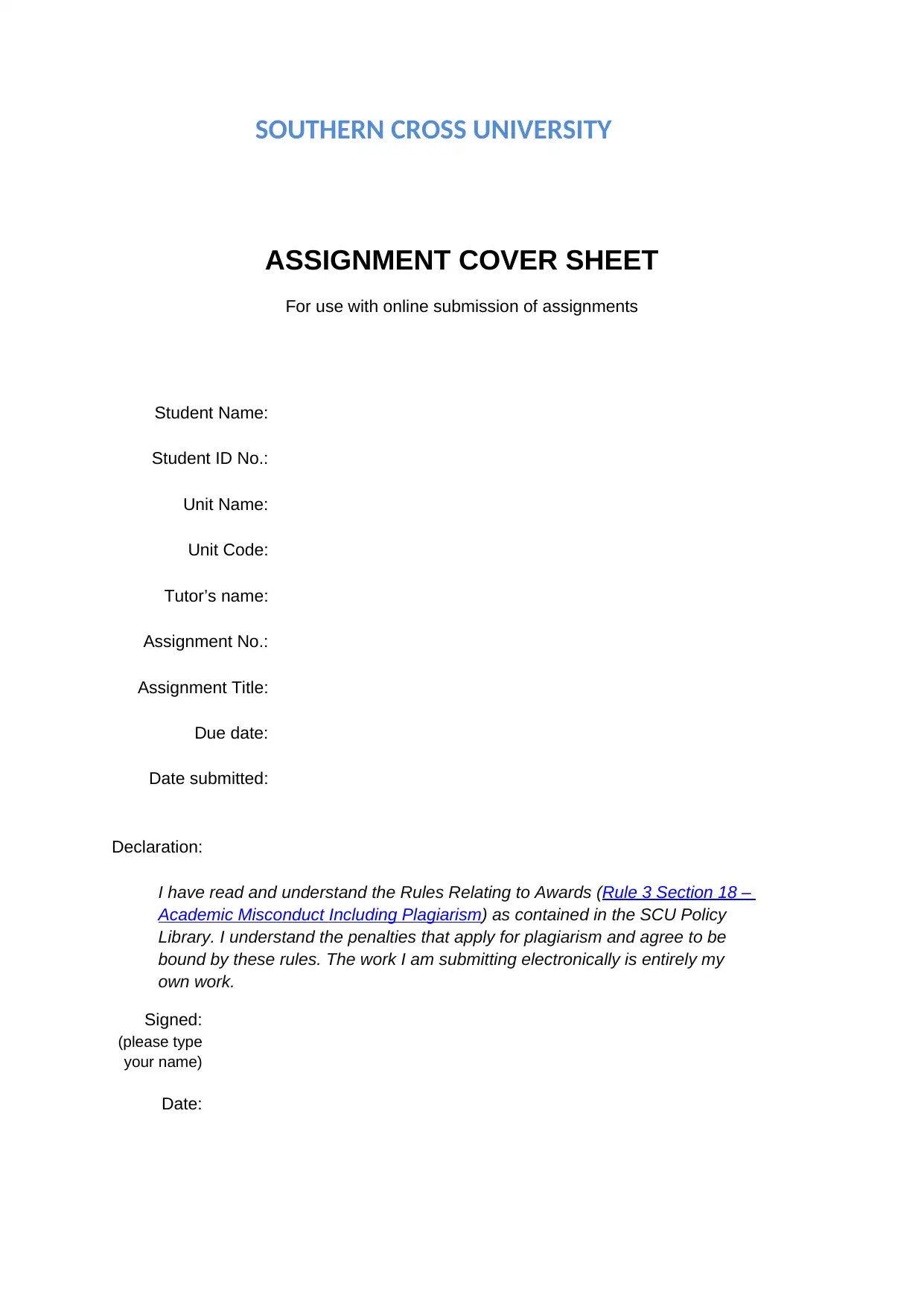
SOUTHERN CROSS UNIVERSITY
ASSIGNMENT COVER SHEET
For use with online submission of assignments
Student Name:
Student ID No.:
Unit Name:
Unit Code:
Tutor’s name:
Assignment No.:
Assignment Title:
Due date:
Date submitted:
Declaration:
I have read and understand the Rules Relating to Awards (Rule 3 Section 18 –
Academic Misconduct Including Plagiarism) as contained in the SCU Policy
Library. I understand the penalties that apply for plagiarism and agree to be
bound by these rules. The work I am submitting electronically is entirely my
own work.
Signed:
(please type
your name)
Date:
ASSIGNMENT COVER SHEET
For use with online submission of assignments
Student Name:
Student ID No.:
Unit Name:
Unit Code:
Tutor’s name:
Assignment No.:
Assignment Title:
Due date:
Date submitted:
Declaration:
I have read and understand the Rules Relating to Awards (Rule 3 Section 18 –
Academic Misconduct Including Plagiarism) as contained in the SCU Policy
Library. I understand the penalties that apply for plagiarism and agree to be
bound by these rules. The work I am submitting electronically is entirely my
own work.
Signed:
(please type
your name)
Date:
Secure Best Marks with AI Grader
Need help grading? Try our AI Grader for instant feedback on your assignments.
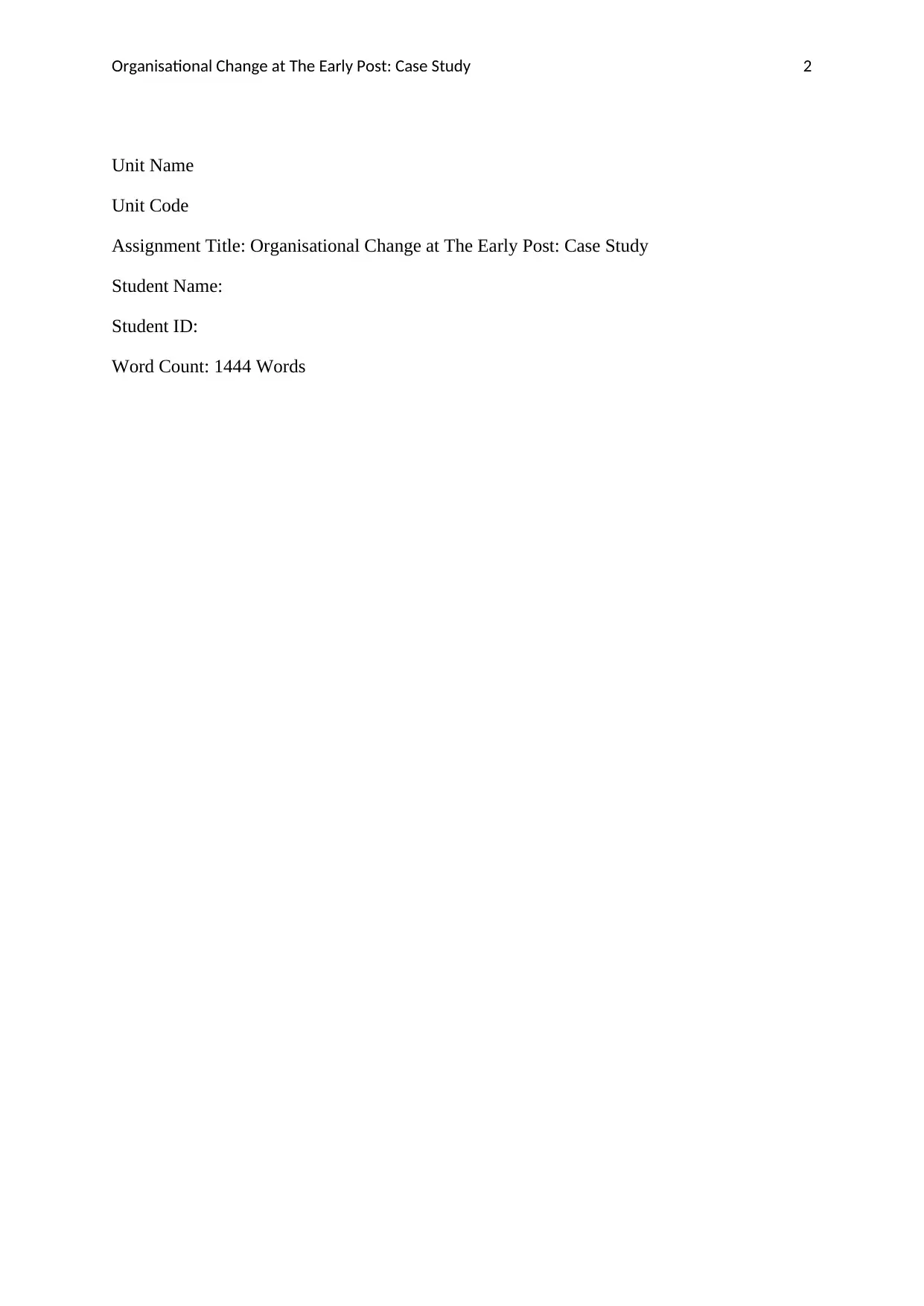
Organisational Change at The Early Post: Case Study 2
Unit Name
Unit Code
Assignment Title: Organisational Change at The Early Post: Case Study
Student Name:
Student ID:
Word Count: 1444 Words
Unit Name
Unit Code
Assignment Title: Organisational Change at The Early Post: Case Study
Student Name:
Student ID:
Word Count: 1444 Words
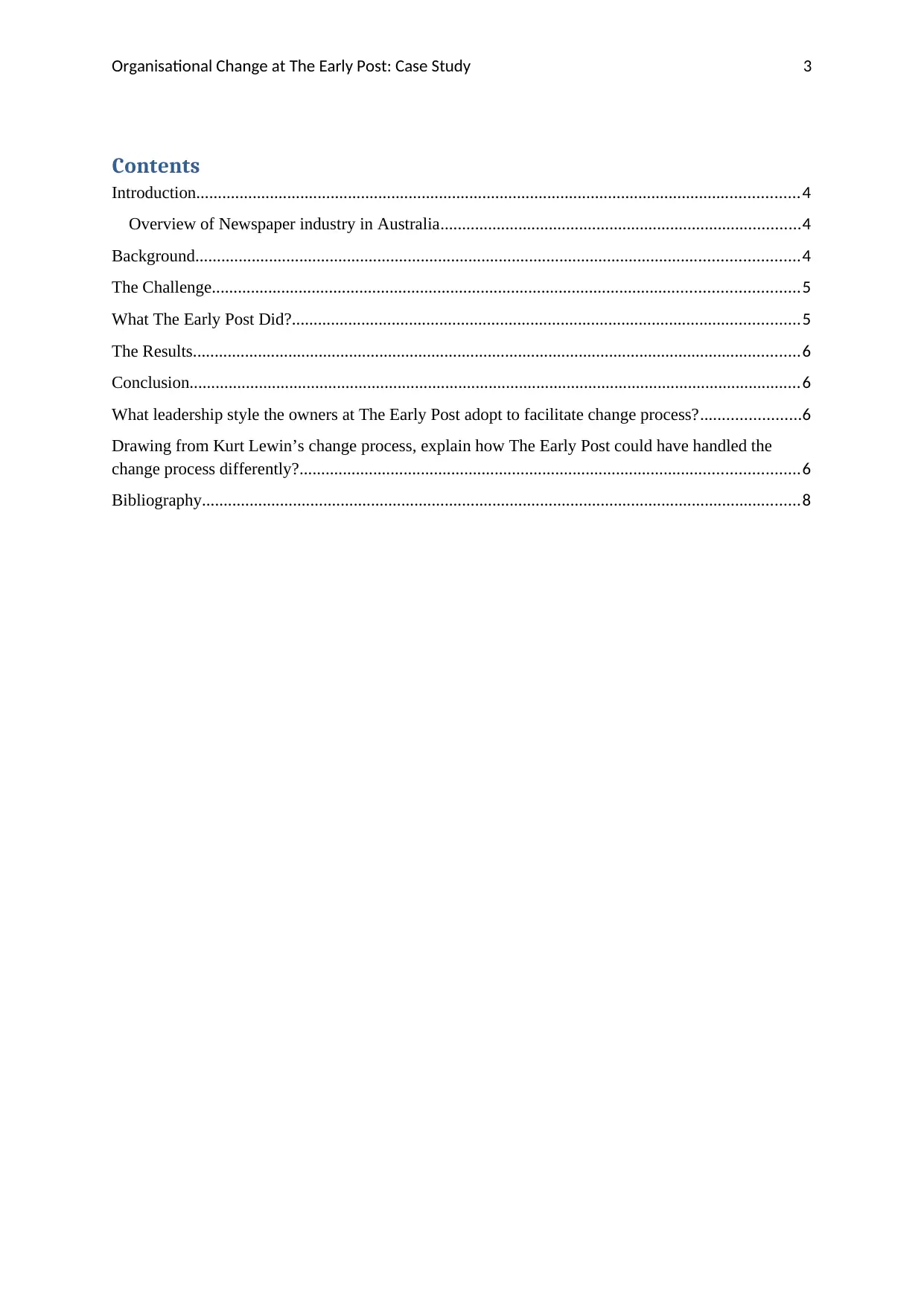
Organisational Change at The Early Post: Case Study 3
Contents
Introduction...........................................................................................................................................4
Overview of Newspaper industry in Australia...................................................................................4
Background...........................................................................................................................................4
The Challenge.......................................................................................................................................5
What The Early Post Did?.....................................................................................................................5
The Results............................................................................................................................................6
Conclusion.............................................................................................................................................6
What leadership style the owners at The Early Post adopt to facilitate change process?.......................6
Drawing from Kurt Lewin’s change process, explain how The Early Post could have handled the
change process differently?...................................................................................................................6
Bibliography..........................................................................................................................................8
Contents
Introduction...........................................................................................................................................4
Overview of Newspaper industry in Australia...................................................................................4
Background...........................................................................................................................................4
The Challenge.......................................................................................................................................5
What The Early Post Did?.....................................................................................................................5
The Results............................................................................................................................................6
Conclusion.............................................................................................................................................6
What leadership style the owners at The Early Post adopt to facilitate change process?.......................6
Drawing from Kurt Lewin’s change process, explain how The Early Post could have handled the
change process differently?...................................................................................................................6
Bibliography..........................................................................................................................................8
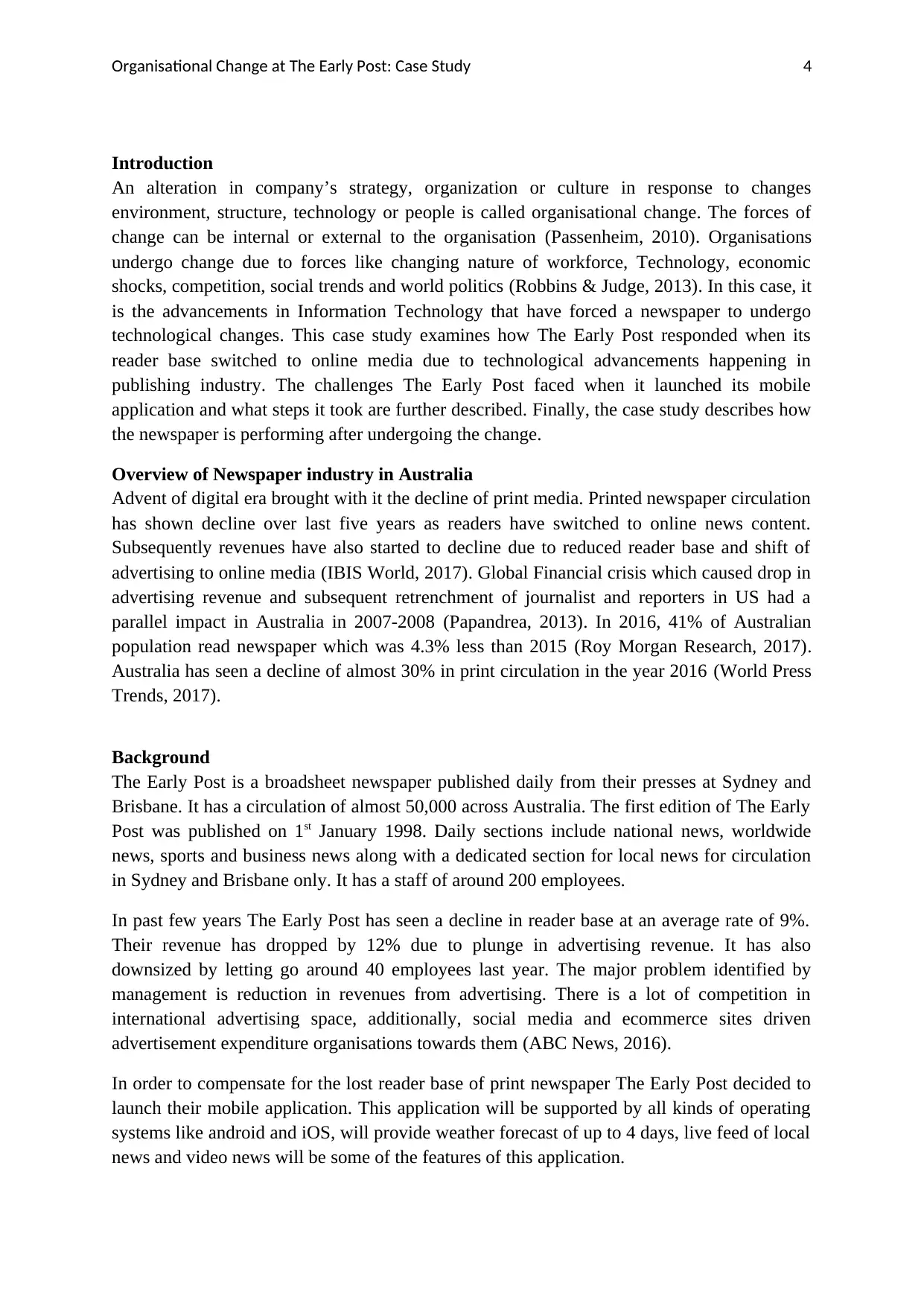
Organisational Change at The Early Post: Case Study 4
Introduction
An alteration in company’s strategy, organization or culture in response to changes
environment, structure, technology or people is called organisational change. The forces of
change can be internal or external to the organisation (Passenheim, 2010). Organisations
undergo change due to forces like changing nature of workforce, Technology, economic
shocks, competition, social trends and world politics (Robbins & Judge, 2013). In this case, it
is the advancements in Information Technology that have forced a newspaper to undergo
technological changes. This case study examines how The Early Post responded when its
reader base switched to online media due to technological advancements happening in
publishing industry. The challenges The Early Post faced when it launched its mobile
application and what steps it took are further described. Finally, the case study describes how
the newspaper is performing after undergoing the change.
Overview of Newspaper industry in Australia
Advent of digital era brought with it the decline of print media. Printed newspaper circulation
has shown decline over last five years as readers have switched to online news content.
Subsequently revenues have also started to decline due to reduced reader base and shift of
advertising to online media (IBIS World, 2017). Global Financial crisis which caused drop in
advertising revenue and subsequent retrenchment of journalist and reporters in US had a
parallel impact in Australia in 2007-2008 (Papandrea, 2013). In 2016, 41% of Australian
population read newspaper which was 4.3% less than 2015 (Roy Morgan Research, 2017).
Australia has seen a decline of almost 30% in print circulation in the year 2016 (World Press
Trends, 2017).
Background
The Early Post is a broadsheet newspaper published daily from their presses at Sydney and
Brisbane. It has a circulation of almost 50,000 across Australia. The first edition of The Early
Post was published on 1st January 1998. Daily sections include national news, worldwide
news, sports and business news along with a dedicated section for local news for circulation
in Sydney and Brisbane only. It has a staff of around 200 employees.
In past few years The Early Post has seen a decline in reader base at an average rate of 9%.
Their revenue has dropped by 12% due to plunge in advertising revenue. It has also
downsized by letting go around 40 employees last year. The major problem identified by
management is reduction in revenues from advertising. There is a lot of competition in
international advertising space, additionally, social media and ecommerce sites driven
advertisement expenditure organisations towards them (ABC News, 2016).
In order to compensate for the lost reader base of print newspaper The Early Post decided to
launch their mobile application. This application will be supported by all kinds of operating
systems like android and iOS, will provide weather forecast of up to 4 days, live feed of local
news and video news will be some of the features of this application.
Introduction
An alteration in company’s strategy, organization or culture in response to changes
environment, structure, technology or people is called organisational change. The forces of
change can be internal or external to the organisation (Passenheim, 2010). Organisations
undergo change due to forces like changing nature of workforce, Technology, economic
shocks, competition, social trends and world politics (Robbins & Judge, 2013). In this case, it
is the advancements in Information Technology that have forced a newspaper to undergo
technological changes. This case study examines how The Early Post responded when its
reader base switched to online media due to technological advancements happening in
publishing industry. The challenges The Early Post faced when it launched its mobile
application and what steps it took are further described. Finally, the case study describes how
the newspaper is performing after undergoing the change.
Overview of Newspaper industry in Australia
Advent of digital era brought with it the decline of print media. Printed newspaper circulation
has shown decline over last five years as readers have switched to online news content.
Subsequently revenues have also started to decline due to reduced reader base and shift of
advertising to online media (IBIS World, 2017). Global Financial crisis which caused drop in
advertising revenue and subsequent retrenchment of journalist and reporters in US had a
parallel impact in Australia in 2007-2008 (Papandrea, 2013). In 2016, 41% of Australian
population read newspaper which was 4.3% less than 2015 (Roy Morgan Research, 2017).
Australia has seen a decline of almost 30% in print circulation in the year 2016 (World Press
Trends, 2017).
Background
The Early Post is a broadsheet newspaper published daily from their presses at Sydney and
Brisbane. It has a circulation of almost 50,000 across Australia. The first edition of The Early
Post was published on 1st January 1998. Daily sections include national news, worldwide
news, sports and business news along with a dedicated section for local news for circulation
in Sydney and Brisbane only. It has a staff of around 200 employees.
In past few years The Early Post has seen a decline in reader base at an average rate of 9%.
Their revenue has dropped by 12% due to plunge in advertising revenue. It has also
downsized by letting go around 40 employees last year. The major problem identified by
management is reduction in revenues from advertising. There is a lot of competition in
international advertising space, additionally, social media and ecommerce sites driven
advertisement expenditure organisations towards them (ABC News, 2016).
In order to compensate for the lost reader base of print newspaper The Early Post decided to
launch their mobile application. This application will be supported by all kinds of operating
systems like android and iOS, will provide weather forecast of up to 4 days, live feed of local
news and video news will be some of the features of this application.
Secure Best Marks with AI Grader
Need help grading? Try our AI Grader for instant feedback on your assignments.
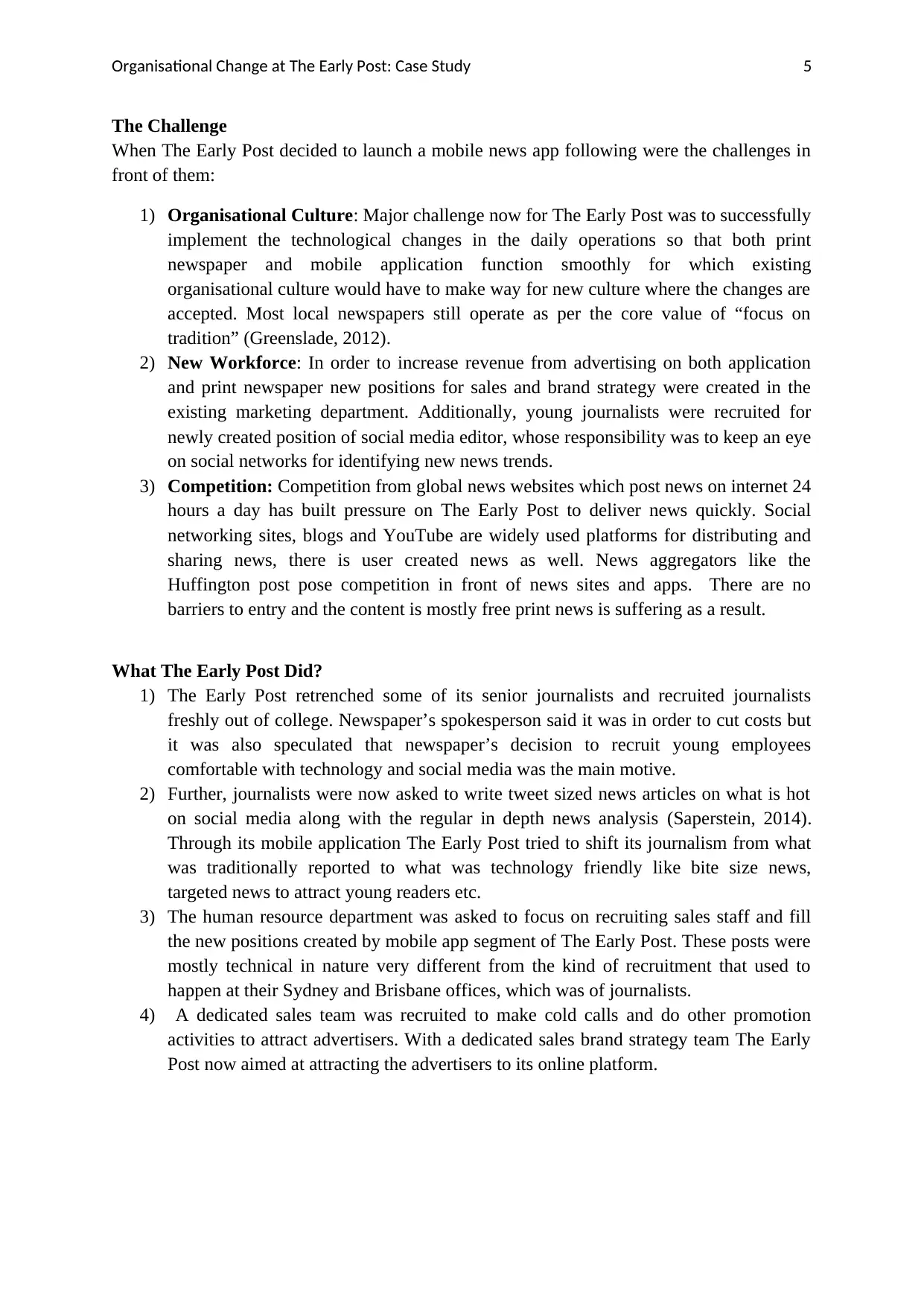
Organisational Change at The Early Post: Case Study 5
The Challenge
When The Early Post decided to launch a mobile news app following were the challenges in
front of them:
1) Organisational Culture: Major challenge now for The Early Post was to successfully
implement the technological changes in the daily operations so that both print
newspaper and mobile application function smoothly for which existing
organisational culture would have to make way for new culture where the changes are
accepted. Most local newspapers still operate as per the core value of “focus on
tradition” (Greenslade, 2012).
2) New Workforce: In order to increase revenue from advertising on both application
and print newspaper new positions for sales and brand strategy were created in the
existing marketing department. Additionally, young journalists were recruited for
newly created position of social media editor, whose responsibility was to keep an eye
on social networks for identifying new news trends.
3) Competition: Competition from global news websites which post news on internet 24
hours a day has built pressure on The Early Post to deliver news quickly. Social
networking sites, blogs and YouTube are widely used platforms for distributing and
sharing news, there is user created news as well. News aggregators like the
Huffington post pose competition in front of news sites and apps. There are no
barriers to entry and the content is mostly free print news is suffering as a result.
What The Early Post Did?
1) The Early Post retrenched some of its senior journalists and recruited journalists
freshly out of college. Newspaper’s spokesperson said it was in order to cut costs but
it was also speculated that newspaper’s decision to recruit young employees
comfortable with technology and social media was the main motive.
2) Further, journalists were now asked to write tweet sized news articles on what is hot
on social media along with the regular in depth news analysis (Saperstein, 2014).
Through its mobile application The Early Post tried to shift its journalism from what
was traditionally reported to what was technology friendly like bite size news,
targeted news to attract young readers etc.
3) The human resource department was asked to focus on recruiting sales staff and fill
the new positions created by mobile app segment of The Early Post. These posts were
mostly technical in nature very different from the kind of recruitment that used to
happen at their Sydney and Brisbane offices, which was of journalists.
4) A dedicated sales team was recruited to make cold calls and do other promotion
activities to attract advertisers. With a dedicated sales brand strategy team The Early
Post now aimed at attracting the advertisers to its online platform.
The Challenge
When The Early Post decided to launch a mobile news app following were the challenges in
front of them:
1) Organisational Culture: Major challenge now for The Early Post was to successfully
implement the technological changes in the daily operations so that both print
newspaper and mobile application function smoothly for which existing
organisational culture would have to make way for new culture where the changes are
accepted. Most local newspapers still operate as per the core value of “focus on
tradition” (Greenslade, 2012).
2) New Workforce: In order to increase revenue from advertising on both application
and print newspaper new positions for sales and brand strategy were created in the
existing marketing department. Additionally, young journalists were recruited for
newly created position of social media editor, whose responsibility was to keep an eye
on social networks for identifying new news trends.
3) Competition: Competition from global news websites which post news on internet 24
hours a day has built pressure on The Early Post to deliver news quickly. Social
networking sites, blogs and YouTube are widely used platforms for distributing and
sharing news, there is user created news as well. News aggregators like the
Huffington post pose competition in front of news sites and apps. There are no
barriers to entry and the content is mostly free print news is suffering as a result.
What The Early Post Did?
1) The Early Post retrenched some of its senior journalists and recruited journalists
freshly out of college. Newspaper’s spokesperson said it was in order to cut costs but
it was also speculated that newspaper’s decision to recruit young employees
comfortable with technology and social media was the main motive.
2) Further, journalists were now asked to write tweet sized news articles on what is hot
on social media along with the regular in depth news analysis (Saperstein, 2014).
Through its mobile application The Early Post tried to shift its journalism from what
was traditionally reported to what was technology friendly like bite size news,
targeted news to attract young readers etc.
3) The human resource department was asked to focus on recruiting sales staff and fill
the new positions created by mobile app segment of The Early Post. These posts were
mostly technical in nature very different from the kind of recruitment that used to
happen at their Sydney and Brisbane offices, which was of journalists.
4) A dedicated sales team was recruited to make cold calls and do other promotion
activities to attract advertisers. With a dedicated sales brand strategy team The Early
Post now aimed at attracting the advertisers to its online platform.
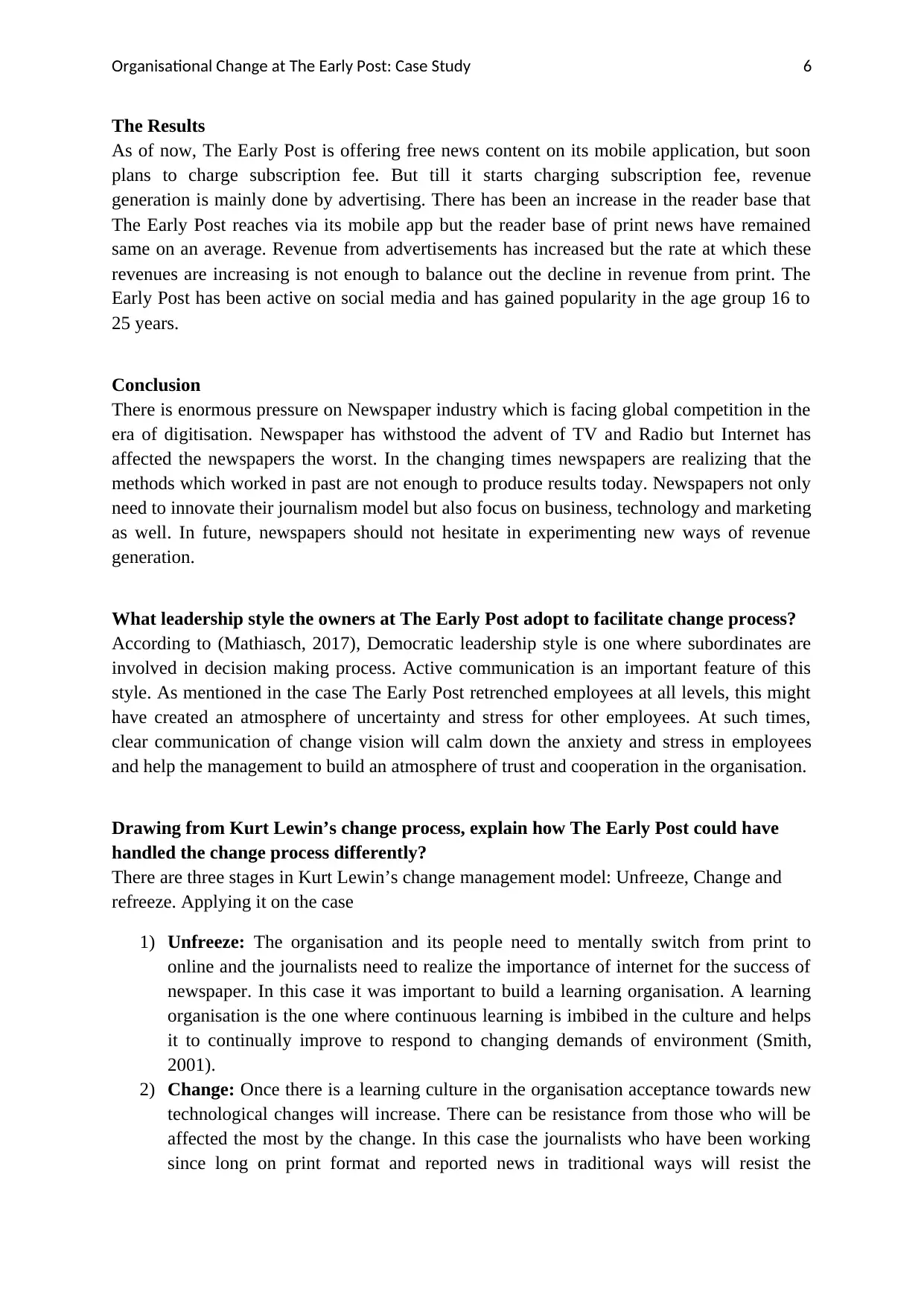
Organisational Change at The Early Post: Case Study 6
The Results
As of now, The Early Post is offering free news content on its mobile application, but soon
plans to charge subscription fee. But till it starts charging subscription fee, revenue
generation is mainly done by advertising. There has been an increase in the reader base that
The Early Post reaches via its mobile app but the reader base of print news have remained
same on an average. Revenue from advertisements has increased but the rate at which these
revenues are increasing is not enough to balance out the decline in revenue from print. The
Early Post has been active on social media and has gained popularity in the age group 16 to
25 years.
Conclusion
There is enormous pressure on Newspaper industry which is facing global competition in the
era of digitisation. Newspaper has withstood the advent of TV and Radio but Internet has
affected the newspapers the worst. In the changing times newspapers are realizing that the
methods which worked in past are not enough to produce results today. Newspapers not only
need to innovate their journalism model but also focus on business, technology and marketing
as well. In future, newspapers should not hesitate in experimenting new ways of revenue
generation.
What leadership style the owners at The Early Post adopt to facilitate change process?
According to (Mathiasch, 2017), Democratic leadership style is one where subordinates are
involved in decision making process. Active communication is an important feature of this
style. As mentioned in the case The Early Post retrenched employees at all levels, this might
have created an atmosphere of uncertainty and stress for other employees. At such times,
clear communication of change vision will calm down the anxiety and stress in employees
and help the management to build an atmosphere of trust and cooperation in the organisation.
Drawing from Kurt Lewin’s change process, explain how The Early Post could have
handled the change process differently?
There are three stages in Kurt Lewin’s change management model: Unfreeze, Change and
refreeze. Applying it on the case
1) Unfreeze: The organisation and its people need to mentally switch from print to
online and the journalists need to realize the importance of internet for the success of
newspaper. In this case it was important to build a learning organisation. A learning
organisation is the one where continuous learning is imbibed in the culture and helps
it to continually improve to respond to changing demands of environment (Smith,
2001).
2) Change: Once there is a learning culture in the organisation acceptance towards new
technological changes will increase. There can be resistance from those who will be
affected the most by the change. In this case the journalists who have been working
since long on print format and reported news in traditional ways will resist the
The Results
As of now, The Early Post is offering free news content on its mobile application, but soon
plans to charge subscription fee. But till it starts charging subscription fee, revenue
generation is mainly done by advertising. There has been an increase in the reader base that
The Early Post reaches via its mobile app but the reader base of print news have remained
same on an average. Revenue from advertisements has increased but the rate at which these
revenues are increasing is not enough to balance out the decline in revenue from print. The
Early Post has been active on social media and has gained popularity in the age group 16 to
25 years.
Conclusion
There is enormous pressure on Newspaper industry which is facing global competition in the
era of digitisation. Newspaper has withstood the advent of TV and Radio but Internet has
affected the newspapers the worst. In the changing times newspapers are realizing that the
methods which worked in past are not enough to produce results today. Newspapers not only
need to innovate their journalism model but also focus on business, technology and marketing
as well. In future, newspapers should not hesitate in experimenting new ways of revenue
generation.
What leadership style the owners at The Early Post adopt to facilitate change process?
According to (Mathiasch, 2017), Democratic leadership style is one where subordinates are
involved in decision making process. Active communication is an important feature of this
style. As mentioned in the case The Early Post retrenched employees at all levels, this might
have created an atmosphere of uncertainty and stress for other employees. At such times,
clear communication of change vision will calm down the anxiety and stress in employees
and help the management to build an atmosphere of trust and cooperation in the organisation.
Drawing from Kurt Lewin’s change process, explain how The Early Post could have
handled the change process differently?
There are three stages in Kurt Lewin’s change management model: Unfreeze, Change and
refreeze. Applying it on the case
1) Unfreeze: The organisation and its people need to mentally switch from print to
online and the journalists need to realize the importance of internet for the success of
newspaper. In this case it was important to build a learning organisation. A learning
organisation is the one where continuous learning is imbibed in the culture and helps
it to continually improve to respond to changing demands of environment (Smith,
2001).
2) Change: Once there is a learning culture in the organisation acceptance towards new
technological changes will increase. There can be resistance from those who will be
affected the most by the change. In this case the journalists who have been working
since long on print format and reported news in traditional ways will resist the
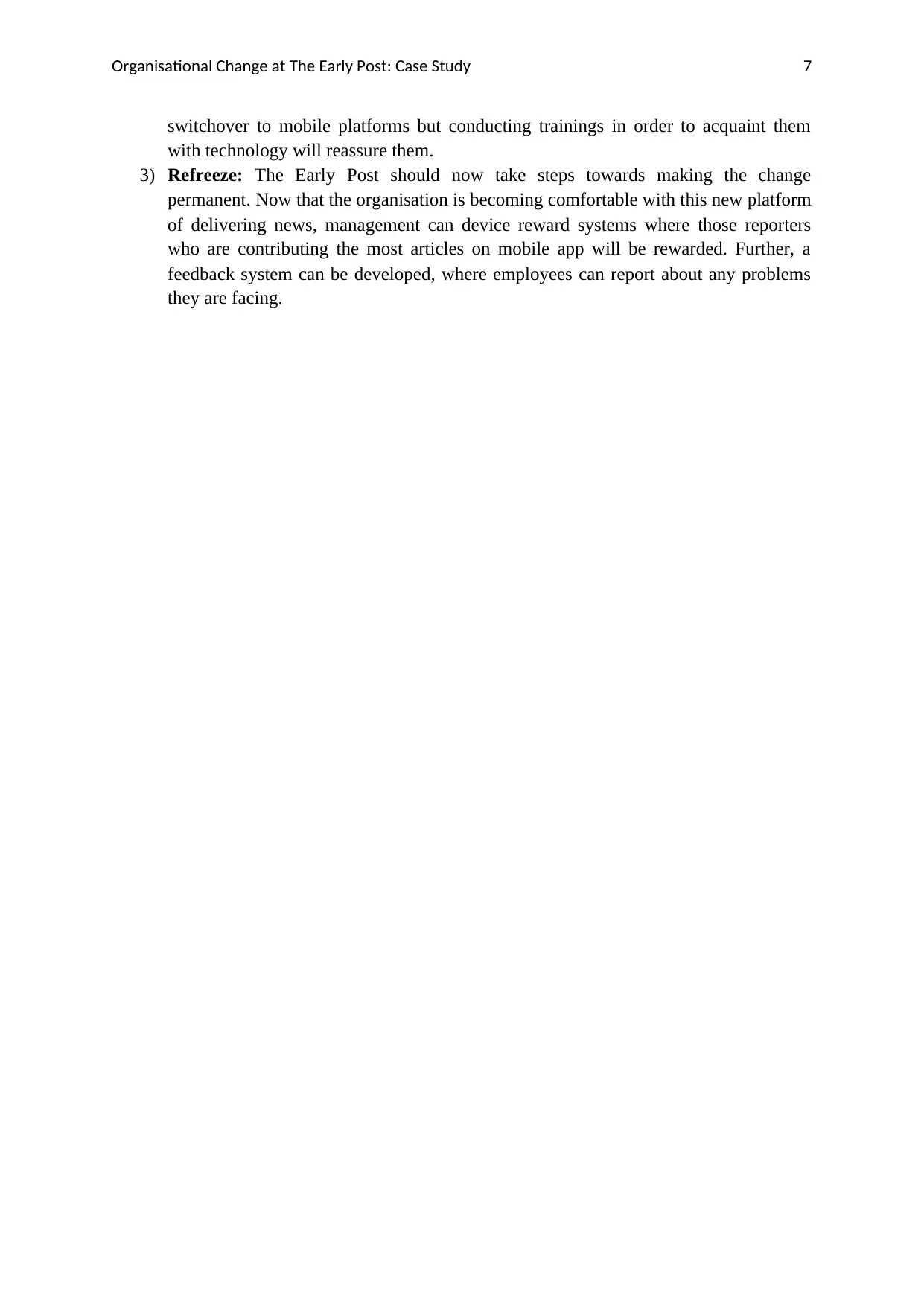
Organisational Change at The Early Post: Case Study 7
switchover to mobile platforms but conducting trainings in order to acquaint them
with technology will reassure them.
3) Refreeze: The Early Post should now take steps towards making the change
permanent. Now that the organisation is becoming comfortable with this new platform
of delivering news, management can device reward systems where those reporters
who are contributing the most articles on mobile app will be rewarded. Further, a
feedback system can be developed, where employees can report about any problems
they are facing.
switchover to mobile platforms but conducting trainings in order to acquaint them
with technology will reassure them.
3) Refreeze: The Early Post should now take steps towards making the change
permanent. Now that the organisation is becoming comfortable with this new platform
of delivering news, management can device reward systems where those reporters
who are contributing the most articles on mobile app will be rewarded. Further, a
feedback system can be developed, where employees can report about any problems
they are facing.
Paraphrase This Document
Need a fresh take? Get an instant paraphrase of this document with our AI Paraphraser
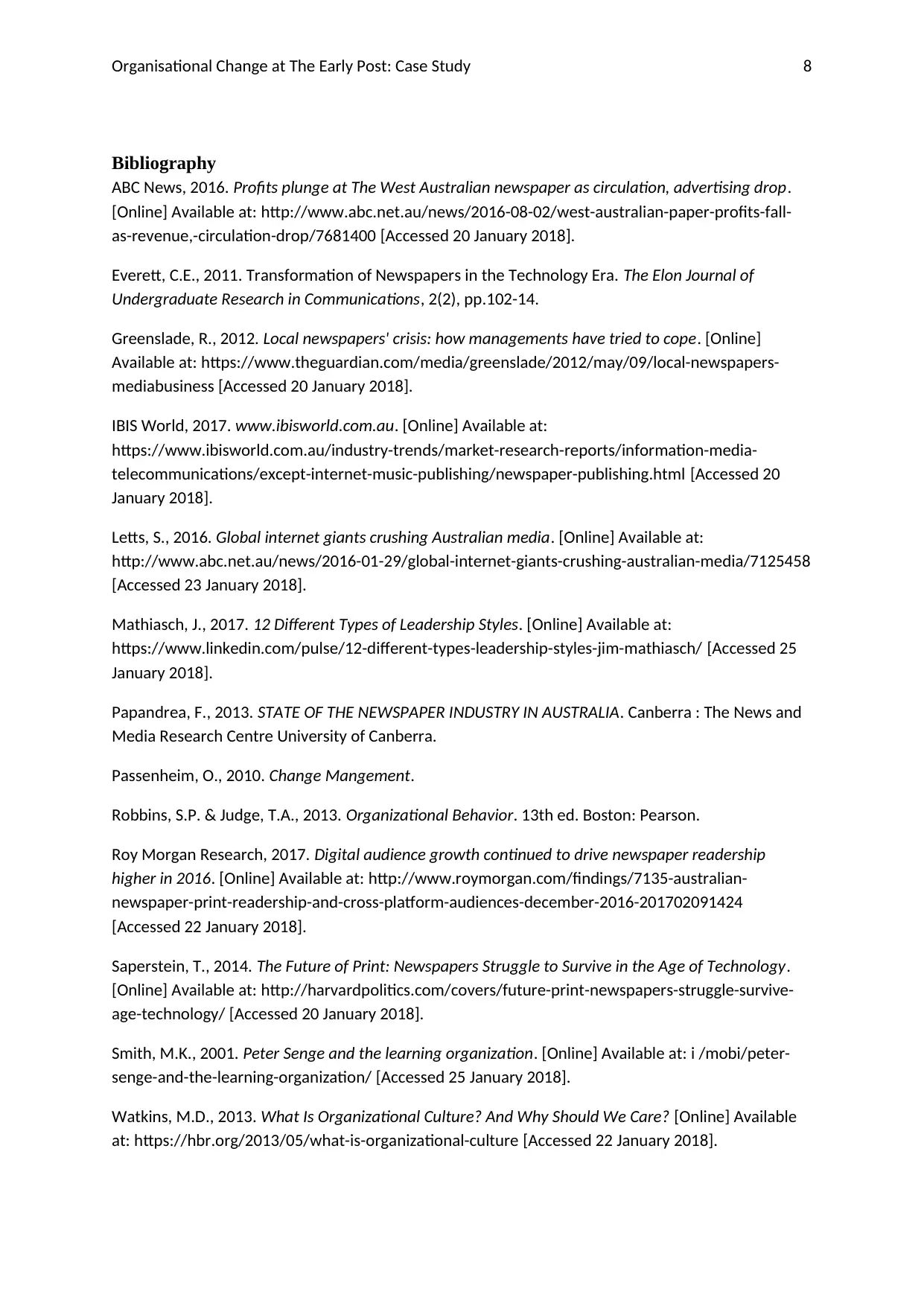
Organisational Change at The Early Post: Case Study 8
Bibliography
ABC News, 2016. Profits plunge at The West Australian newspaper as circulation, advertising drop.
[Online] Available at: http://www.abc.net.au/news/2016-08-02/west-australian-paper-profits-fall-
as-revenue,-circulation-drop/7681400 [Accessed 20 January 2018].
Everett, C.E., 2011. Transformation of Newspapers in the Technology Era. The Elon Journal of
Undergraduate Research in Communications, 2(2), pp.102-14.
Greenslade, R., 2012. Local newspapers' crisis: how managements have tried to cope. [Online]
Available at: https://www.theguardian.com/media/greenslade/2012/may/09/local-newspapers-
mediabusiness [Accessed 20 January 2018].
IBIS World, 2017. www.ibisworld.com.au. [Online] Available at:
https://www.ibisworld.com.au/industry-trends/market-research-reports/information-media-
telecommunications/except-internet-music-publishing/newspaper-publishing.html [Accessed 20
January 2018].
Letts, S., 2016. Global internet giants crushing Australian media. [Online] Available at:
http://www.abc.net.au/news/2016-01-29/global-internet-giants-crushing-australian-media/7125458
[Accessed 23 January 2018].
Mathiasch, J., 2017. 12 Different Types of Leadership Styles. [Online] Available at:
https://www.linkedin.com/pulse/12-different-types-leadership-styles-jim-mathiasch/ [Accessed 25
January 2018].
Papandrea, F., 2013. STATE OF THE NEWSPAPER INDUSTRY IN AUSTRALIA. Canberra : The News and
Media Research Centre University of Canberra.
Passenheim, O., 2010. Change Mangement.
Robbins, S.P. & Judge, T.A., 2013. Organizational Behavior. 13th ed. Boston: Pearson.
Roy Morgan Research, 2017. Digital audience growth continued to drive newspaper readership
higher in 2016. [Online] Available at: http://www.roymorgan.com/findings/7135-australian-
newspaper-print-readership-and-cross-platform-audiences-december-2016-201702091424
[Accessed 22 January 2018].
Saperstein, T., 2014. The Future of Print: Newspapers Struggle to Survive in the Age of Technology.
[Online] Available at: http://harvardpolitics.com/covers/future-print-newspapers-struggle-survive-
age-technology/ [Accessed 20 January 2018].
Smith, M.K., 2001. Peter Senge and the learning organization. [Online] Available at: i /mobi/peter-
senge-and-the-learning-organization/ [Accessed 25 January 2018].
Watkins, M.D., 2013. What Is Organizational Culture? And Why Should We Care? [Online] Available
at: https://hbr.org/2013/05/what-is-organizational-culture [Accessed 22 January 2018].
Bibliography
ABC News, 2016. Profits plunge at The West Australian newspaper as circulation, advertising drop.
[Online] Available at: http://www.abc.net.au/news/2016-08-02/west-australian-paper-profits-fall-
as-revenue,-circulation-drop/7681400 [Accessed 20 January 2018].
Everett, C.E., 2011. Transformation of Newspapers in the Technology Era. The Elon Journal of
Undergraduate Research in Communications, 2(2), pp.102-14.
Greenslade, R., 2012. Local newspapers' crisis: how managements have tried to cope. [Online]
Available at: https://www.theguardian.com/media/greenslade/2012/may/09/local-newspapers-
mediabusiness [Accessed 20 January 2018].
IBIS World, 2017. www.ibisworld.com.au. [Online] Available at:
https://www.ibisworld.com.au/industry-trends/market-research-reports/information-media-
telecommunications/except-internet-music-publishing/newspaper-publishing.html [Accessed 20
January 2018].
Letts, S., 2016. Global internet giants crushing Australian media. [Online] Available at:
http://www.abc.net.au/news/2016-01-29/global-internet-giants-crushing-australian-media/7125458
[Accessed 23 January 2018].
Mathiasch, J., 2017. 12 Different Types of Leadership Styles. [Online] Available at:
https://www.linkedin.com/pulse/12-different-types-leadership-styles-jim-mathiasch/ [Accessed 25
January 2018].
Papandrea, F., 2013. STATE OF THE NEWSPAPER INDUSTRY IN AUSTRALIA. Canberra : The News and
Media Research Centre University of Canberra.
Passenheim, O., 2010. Change Mangement.
Robbins, S.P. & Judge, T.A., 2013. Organizational Behavior. 13th ed. Boston: Pearson.
Roy Morgan Research, 2017. Digital audience growth continued to drive newspaper readership
higher in 2016. [Online] Available at: http://www.roymorgan.com/findings/7135-australian-
newspaper-print-readership-and-cross-platform-audiences-december-2016-201702091424
[Accessed 22 January 2018].
Saperstein, T., 2014. The Future of Print: Newspapers Struggle to Survive in the Age of Technology.
[Online] Available at: http://harvardpolitics.com/covers/future-print-newspapers-struggle-survive-
age-technology/ [Accessed 20 January 2018].
Smith, M.K., 2001. Peter Senge and the learning organization. [Online] Available at: i /mobi/peter-
senge-and-the-learning-organization/ [Accessed 25 January 2018].
Watkins, M.D., 2013. What Is Organizational Culture? And Why Should We Care? [Online] Available
at: https://hbr.org/2013/05/what-is-organizational-culture [Accessed 22 January 2018].
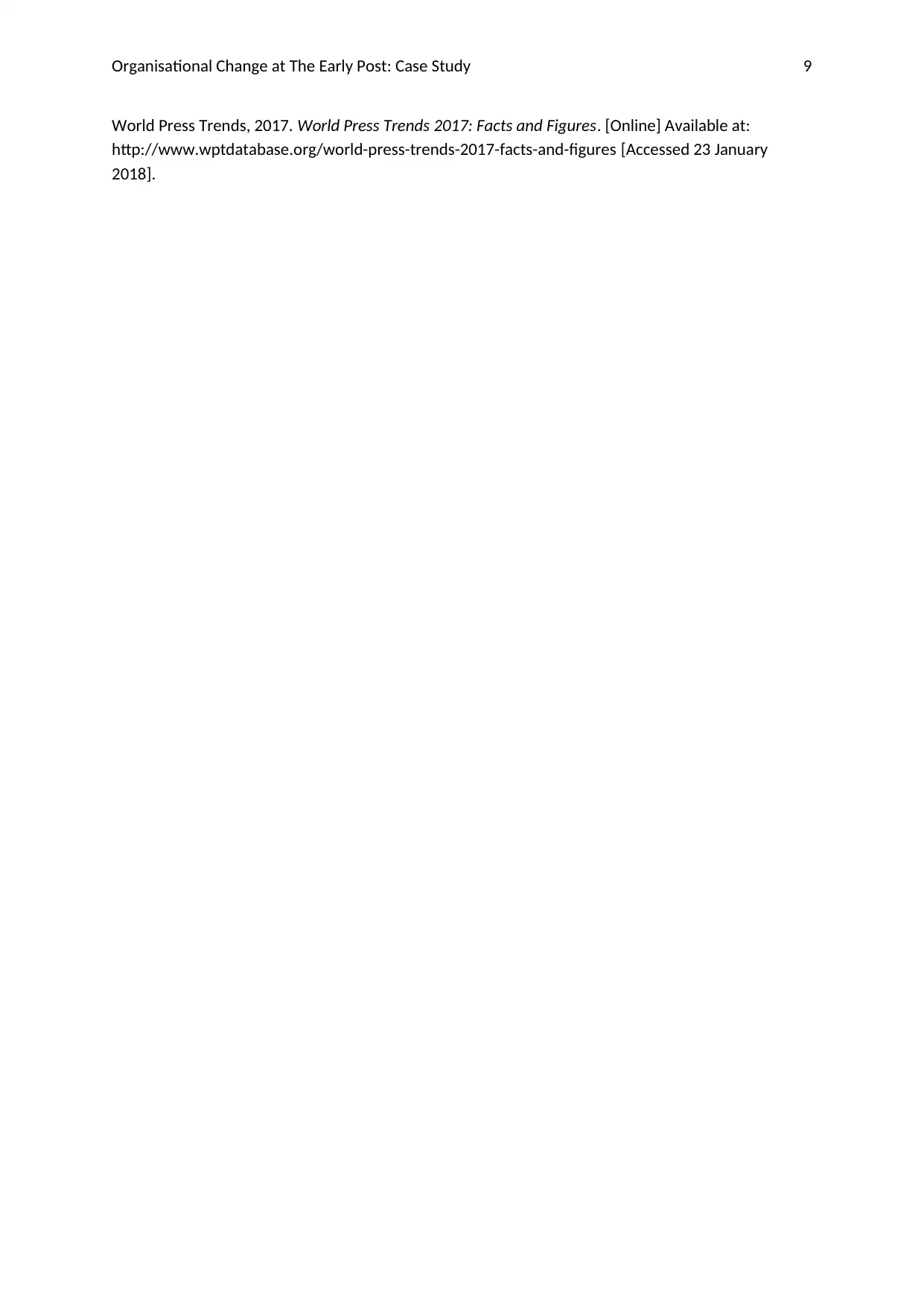
Organisational Change at The Early Post: Case Study 9
World Press Trends, 2017. World Press Trends 2017: Facts and Figures. [Online] Available at:
http://www.wptdatabase.org/world-press-trends-2017-facts-and-figures [Accessed 23 January
2018].
World Press Trends, 2017. World Press Trends 2017: Facts and Figures. [Online] Available at:
http://www.wptdatabase.org/world-press-trends-2017-facts-and-figures [Accessed 23 January
2018].
1 out of 9
Related Documents
Your All-in-One AI-Powered Toolkit for Academic Success.
+13062052269
info@desklib.com
Available 24*7 on WhatsApp / Email
![[object Object]](/_next/static/media/star-bottom.7253800d.svg)
Unlock your academic potential
© 2024 | Zucol Services PVT LTD | All rights reserved.


